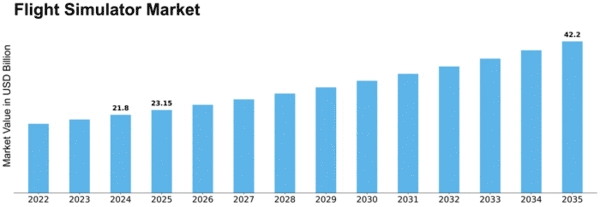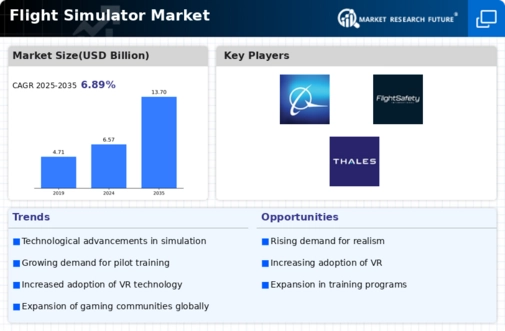-
EXECUTIVE SUMMARY
-
MARKET ATTRACTIVENESS ANALYSIS
- GLOBAL FLIGHT SIMULATOR MARKET, BY PLATFORM
- GLOBAL FLIGHT SIMULATOR MARKET, BY SIMULATION TYPE
- GLOBAL FLIGHT SIMULATOR MARKET, BY REGION
-
MARKET INTRODUCTION
-
DEFINITION
-
SCOPE OF THE STUDY
-
RESEARCH OBJECTIVE
-
MARKET STRUCTURE
-
KEY BUYING CRITERIA
-
RESEARCH METHODOLOGY
-
RESEARCH PROCESS
-
PRIMARY RESEARCH
-
SECONDARY RESEARCH
-
MARKET SIZE ESTIMATION
-
FORECAST MODEL
-
LIST OF ASSUMPTIONS
-
MARKET INSIGHTS
-
MARKET DYNAMICS
-
INTRODUCTION
-
DRIVERS
- GROWING DEMAND FOR PILOTS IN THE AVIATION INDUSTRY
- NEED TO REDUCE PILOT TRAINING COSTS
- FOCUS ON IMPLEMENTING FLIGHT SIMULATORS FOR TRAINING COMBAT AIRCRAFT PILOTS
- DRIVERS IMPACT ANALYSIS
-
RESTRAINTS
- LIMITED REPLICATION OF PHYSIOLOGICAL AND ENVIRONMENTAL FACTORS
- RESTRAINTS IMPACT ANALYSIS
-
OPPORTUNITIES
- INCREASING USE OF UAVS AND SUBSEQUENT FOCUS ON DRONE SIMULATORS
- RISING ADOPTION OF AR TECHNOLOGY IN THE AEROSPACE & DEFENSE INDUSTRY
-
MARKET FACTOR ANALYSIS
-
SUPPLY CHAIN ANALYSIS
- DESIGN AND DEVELOPMENT
- RAW MATERIAL/COMPONENT SUPPLY
- MANUFACTURERS/INTEGRATED SOLUTION PROVIDERS
- SUPPLY AND DISTRIBUTION
- END USE
-
PORTER’S FIVE FORCES MODEL
- THREAT OF NEW ENTRANTS
- BARGAINING POWER OF SUPPLIERS
- BARGAINING POWER OF BUYERS
- THREAT OF SUBSTITUTES
- INTENSITY OF RIVALRY
-
TECHNOLOGICAL TRENDS
-
PATENT TRENDS
-
REGULATORY LANDSCAPE/STANDARDS
-
GLOBAL FLIGHT SIMULATOR MARKET, BY PLATFORM
-
OVERVIEW
-
GLOBAL FLIGHT SIMULATOR MARKET, BY PLATFORM, 2022-2030 (USD MILLION)
-
COMMERCIAL AEROSPACE
- COMMERCIAL AEROSPACE: MARKET ESTIMATES & FORECAST, 2022-2030(USD MILLION)
- COMMERCIAL AEROSPACE: MARKET ESTIMATES & FORECAST, BY REGION, 2022-2030 (USD MILLION)
- COMMERCIAL AEROSPACE: MARKET ESTIMATES & FORECAST, BY TYPE, 2022-2030 (USD MILLION)
- FULL FLIGHT SIMULATORS
- FLIGHT TRAINING DEVICES
-
MILITARY AEROSPACE
- MILITARY AEROSPACE: MARKET ESTIMATES & FORECAST, 2022-2030 (USD MILLION)
- MILITARY AEROSPACE: MARKET ESTIMATES & FORECAST, BY REGION, 2022-2030 (USD MILLION)
- MILITARY AEROSPACE: MARKET ESTIMATES & FORECAST, BY TYPE, 2022-2030 (USD MILLION)
- AIR COMBAT SIMULATOR
- BASIC FLIGHT TRAINER
- COMPUTER-BASED TRAINING
- FULL MISSION SIMULATOR
- OTHERS
-
GLOBAL FLIGHT SIMULATOR MARKET, BY AIRCRAFT TYPE
-
OVERVIEW
-
GLOBAL FLIGHT SIMULATOR MARKET, BY AIRCRAFT TYPE, 2022-2030 (USD MILLION)
-
FIXED WING AIRCRAFT
- FIXED WING AIRCRAFT: MARKET ESTIMATES & FORECAST, 2022-2030(USD MILLION)
- FIXED WING AIRCRAFT: MARKET ESTIMATES & FORECAST, BY REGION, 2022-2030 (USD MILLION)
-
ROTARY WING AIRCRAFT
- ROTARY WING AIRCRAFT: MARKET ESTIMATES & FORECAST, 2022-2030 (USD MILLION)
- ROTARY WING AIRCRAFT: MARKET ESTIMATES & FORECAST, BY REGION, 2022-2030 (USD MILLION)
-
UAV
- UAV: MARKET ESTIMATES & FORECAST, 2022-2030 (USD MILLION)
- UAV: MARKET ESTIMATES & FORECAST, BY REGION, 2022-2030 (USD MILLION)
-
GLOBAL FLIGHT SIMULATOR MARKET, BY SIMULATION TYPE
-
OVERVIEW
-
GLOBAL FLIGHT SIMULATOR MARKET, BY SIMULATION TYPE, 2022-2030 (USD MILLION)
-
LIVE SIMULATION
- LIVE SIMULATION: MARKET ESTIMATES & FORECAST, 2022-2030(USD MILLION)
- LIVE SIMULATION: MARKET ESTIMATES & FORECAST, BY REGION, 2022-2030 (USD MILLION)
-
VIRTUAL SIMULATION
- VIRTUAL SIMULATION: MARKET ESTIMATES & FORECAST, 2022-2030 (USD MILLION)
- VIRTUAL SIMULATION: MARKET ESTIMATES & FORECAST, BY REGION, 2022-2030 (USD MILLION)
-
GLOBAL FLIGHT SIMULATOR MARKET, BY REGION
-
OVERVIEW
- GLOBAL FLIGHT SIMULATOR MARKET, BY REGION, 2022-2030 (USD MILLION)
-
NORTH AMERICA
- NORTH AMERICA: FLIGHT SIMULATOR MARKET, 2022-2030 (USD MILLION)
- NORTH AMERICA: FLIGHT SIMULATOR MARKET, BY COUNTRY, 2022-2030 (USD MILLION)
- NORTH AMERICA: FLIGHT SIMULATOR MARKET, BY PLATFORM, 2022-2030 (USD MILLION)
- NORTH AMERICA: FLIGHT SIMULATOR MARKET, BY AIRCRAFT TYPE, 2022-2030 (USD MILLION)
- NORTH AMERICA: FLIGHT SIMULATOR MARKET, BY SIMULATION TYPE, 2022-2030 (USD MILLION)
- US
- CANADA
-
(USD MILLION)
-
(USD MILLION)
-
(USD MILLION)
-
(USD MILLION)
-
(USD MILLION)
-
EUROPE
- EUROPE: FLIGHT SIMULATOR MARKET, BY REGION, 2022-2030 (USD MILLION)
- EUROPE: FLIGHT SIMULATOR MARKET, BY COUNTRY, 2022-2030 (USD MILLION)
- EUROPE: FLIGHT SIMULATOR MARKET, BY PLATFORM, 2022-2030 (USD MILLION)
- EUROPE: FLIGHT SIMULATOR MARKET, BY AIRCRAFT TYPE, 2022-2030 (USD MILLION)
- EUROPE: FLIGHT SIMULATOR MARKET, BY SIMULATION TYPE, 2022-2030 (USD MILLION)
- UK
- GERMANY
- FRANCE
- RUSSIA
- REST OF EUROPE
-
(USD MILLION)
-
(USD MILLION)
-
(USD MILLION)
-
(USD MILLION)
-
(USD MILLION)
-
(USD MILLION)
-
(USD MILLION)
-
(USD MILLION)
-
(USD MILLION)
-
(USD MILLION)
-
ASIA-PACIFIC
- ASIA-PACIFIC: FLIGHT SIMULATOR MARKET, BY REGION, 2022-2030 (USD MILLION)
- ASIA-PACIFIC: FLIGHT SIMULATOR MARKET, BY COUNTRY, 2022-2030 (USD MILLION)
- ASIA-PACIFIC: FLIGHT SIMULATOR MARKET, BY PLATFORM, 2022-2030 (USD MILLION)
- ASIA-PACIFIC: FLIGHT SIMULATOR MARKET, BY AIRCRAFT TYPE, 2022-2030 (USD MILLION)
- ASIA-PACIFIC: FLIGHT SIMULATOR MARKET, BY SIMULATION TYPE, 2022-2030 (USD MILLION)
- CHINA
- INDIA
- JAPAN
- AUSTRALIA
- REST OF ASIA-PACIFIC
-
(USD MILLION)
-
(USD MILLION)
-
(USD MILLION)
-
(USD MILLION)
-
(USD MILLION)
-
(USD MILLION)
-
(USD MILLION)
-
(USD MILLION)
-
(USD MILLION)
-
(USD MILLION)
-
MIDDLE EAST & AFRICA
- MIDDLE EAST & AFRICA: FLIGHT SIMULATOR MARKET, BY REGION, 2022-2030 (USD MILLION)
- MIDDLE EAST & AFRICA: FLIGHT SIMULATOR MARKET, BY COUNTRY, 2022-2030 (USD MILLION)
- MIDDLE EAST & AFRICA: FLIGHT SIMULATOR MARKET, BY PLATFORM, 2022-2030 (USD MILLION)
- MIDDLE EAST & AFRICA: FLIGHT SIMULATOR MARKET, BY AIRCRAFT TYPE, 2022-2030 (USD MILLION)
- MIDDLE EAST & AFRICA: FLIGHT SIMULATOR MARKET, BY SIMULATION TYPE, 2022-2030 (USD MILLION)
- SAUDI ARABIA
- UAE
- ISRAEL
- REST OF THE MIDDLE EAST & AFRICA
-
(USD MILLION)
-
(USD MILLION)
-
(USD MILLION)
-
(USD MILLION)
-
(USD MILLION)
-
(USD MILLION)
-
(USD MILLION)
-
(USD MILLION)
-
(USD MILLION)
-
LATIN AMERICA
- LATIN AMERICA: FLIGHT SIMULATOR MARKET, BY REGION, 2022-2030 (USD MILLION)
- LATIN AMERICA: FLIGHT SIMULATOR MARKET, BY COUNTRY, 2022-2030 (USD MILLION)
- LATIN AMERICA: FLIGHT SIMULATOR MARKET, BY PLATFORM, 2022-2030 (USD MILLION)
- LATIN AMERICA: FLIGHT SIMULATOR MARKET, BY AIRCRAFT TYPE, 2022-2030 (USD MILLION)
- LATIN AMERICA: FLIGHT SIMULATOR MARKET, BY SIMULATION TYPE, 2022-2030 (USD MILLION)
- BRAZIL
- REST OF LATIN AMERICA
-
(USD MILLION)
-
(USD MILLION)
-
(USD MILLION)
-
(USD MILLION)
-
(USD MILLION)
-
COMPETITIVE LANDSCAPE
-
COMPETITIVE OVERVIEW
-
COMPETITIVE BENCHMARKING
-
MARKET SHARE ANALYSIS
-
LEADING PLAYERS IN TERMS OF NUMBER OF DEVELOPMENTS IN THE GLOBAL FLIGHT SIMULATOR MARKET
-
KEY DEVELOPMENTS AND GROWTH STRATEGIES
- CONTRACTS AND AGREEMENTS
- NEW PRODUCT DEVELOPMENTS/LAUNCHES
- JOINT VENTURES & ACQUISITIONS
- PARTNERSHIPS, COLLABORATIONS, AND EXPANSIONS
-
COMPANY PROFILES
-
ADVANCED ROTORCRAFT TECHNOLOGY, INC.
- COMPANY OVERVIEW
- FINANCIAL OVERVIEW
- PRODUCTS/SERVICES OFFERED
- KEY DEVELOPMENTS
- SWOT ANALYSIS
- KEY STRATEGIES
-
BOEING
- COMPANY OVERVIEW
- FINANCIAL OVERVIEW
- PRODUCTS/SERVICES OFFERED
- KEY DEVELOPMENTS
- SWOT ANALYSIS
- KEY STRATEGIES
-
CAE INC.
- COMPANY OVERVIEW
- FINANCIAL OVERVIEW
- PRODUCTS/SERVICES OFFERED
- KEY DEVELOPMENTS
- SWOT ANALYSIS
- KEY STRATEGIES
-
FLIGHTSAFETY INTERNATIONAL
- COMPANY OVERVIEW
- FINANCIAL OVERVIEW
- PRODUCTS/SERVICES OFFERED
- KEY DEVELOPMENTS
- SWOT ANALYSIS
- KEY STRATEGIES
-
FRASCA INTERNATIONAL INC.
- COMPANY OVERVIEW
- FINANCIAL OVERVIEW
- PRODUCTS/SERVICES OFFERED
- KEY DEVELOPMENTS
- SWOT ANALYSIS
- KEY STRATEGIES
-
L3HARRIS TECHNOLOGIES, INC.
- COMPANY OVERVIEW
- FINANCIAL OVERVIEW
- PRODUCTS/SERVICES OFFERED
- KEY DEVELOPMENTS
- SWOT ANALYSIS
- KEY STRATEGIES
-
LOCKHEED MARTIN CORPORATION
- COMPANY OVERVIEW
- FINANCIAL OVERVIEW
- PRODUCTS/SERVICES OFFERED
- KEY DEVELOPMENTS
- SWOT ANALYSIS
- KEY STRATEGIES
-
THALES GROUP
- COMPANY OVERVIEW
- FINANCIAL OVERVIEW
- PRODUCTS/SERVICES OFFERED
- KEY DEVELOPMENTS
- SWOT ANALYSIS
- KEY STRATEGIES
-
TRU SIMULATION + TRAINING INC.
- COMPANY OVERVIEW
- FINANCIAL OVERVIEW
- PRODUCTS/SERVICES OFFERED
- KEY DEVELOPMENTS
- SWOT ANALYSIS
- KEY STRATEGIES
-
UNITED TECHNOLOGIES CORPORATION
- COMPANY OVERVIEW
- FINANCIAL OVERVIEW
- PRODUCTS/SERVICES OFFERED
- KEY DEVELOPMENTS
- SWOT ANALYSIS
- KEY STRATEGIES
-
OTHER PROMINENT PLAYERS IN THE MARKET
-
APPENDIX
-
REFERENCES
-
RELATED REPORTS
-
LIST OF ABBREVIATION
-
LIST OF TABLES
-
PRIMARY INTERVIEWS
-
LIST OF ASSUMPTIONS
-
MAJOR PATENTS GRANTED FOR FLIGHT SIMULATORS (1 MARCH 2014–1 MARCH 2019)
-
GLOBAL FLIGHT SIMULATOR MARKET: REGULATORY LANDSCAPE/STANDARDS:
-
GLOBAL FLIGHT SIMULATOR MARKET, BY PLATFORM, 2022-2030 (USD MILLION)
-
COMMERCIAL AEROSPACE: MARKET ESTIMATES & FORECAST, 2022-2030 (USD MILLION)
-
COMMERCIAL AEROSPACE: MARKET ESTIMATES & FORECAST, BY REGION, 2022-2030 (USD MILLION)
-
COMMERCIAL AEROSPACE: MARKET ESTIMATES & FORECAST, BY TYPE, 2022-2030 (USD MILLION)
-
FULL FLIGHT SIMULATORS: MARKET ESTIMATES & FORECAST, 2022-2030 (USD MILLION)
-
FULL FLIGHT SIMULATORS: MARKET ESTIMATES & FORECAST, BY REGION, 2022-2030 (USD MILLION)
-
FLIGHT TRAINING DEVICES: MARKET ESTIMATES & FORECAST, 2022-2030 (USD MILLION)
-
FLIGHT TRAINING DEVICES: MARKET ESTIMATES & FORECAST, BY REGION, 2022-2030 (USD MILLION)
-
MILITARY AEROSPACE: MARKET ESTIMATES & FORECAST, 2022-2030 (USD MILLION)
-
MILITARY AEROSPACE: MARKET ESTIMATES & FORECAST, BY REGION, 2022-2030 (USD MILLION)
-
MILITARY AEROSPACE: MARKET ESTIMATES & FORECAST, BY TYPE, 2022-2030 (USD MILLION)
-
AIR COMBAT SIMULATOR: MARKET ESTIMATES & FORECAST, 2022-2030 (USD MILLION)
-
AIR COMBAT SIMULATOR: MARKET ESTIMATES & FORECAST, BY REGION, 2022-2030 (USD MILLION)
-
BASIC FLIGHT TRAINER: MARKET ESTIMATES & FORECAST, 2022-2030 (USD MILLION)
-
BASIC FLIGHT TRAINER: MARKET ESTIMATES & FORECAST, BY REGION, 2022-2030 (USD MILLION)
-
COMPUTER-BASED TRAINING: MARKET ESTIMATES & FORECAST, 2022-2030 (USD MILLION)
-
COMPUTER-BASED TRAINING: MARKET ESTIMATES & FORECAST, BY REGION, 2022-2030 (USD MILLION)
-
FULL MISSION SIMULATOR: MARKET ESTIMATES & FORECAST, 2022-2030 (USD MILLION)
-
FULL MISSION SIMULATOR: MARKET ESTIMATES & FORECAST, BY REGION, 2022-2030 (USD MILLION)
-
OTHERS: MARKET ESTIMATES & FORECAST, 2022-2030 (USD MILLION)
-
OTHERS: MARKET ESTIMATES & FORECAST, BY REGION, 2022-2030 (USD MILLION)
-
GLOBAL FLIGHT SIMULATOR MARKET, BY AIRCRAFT TYPE, 2022-2030 (USD MILLION)
-
FIXED WING AIRCRAFT: MARKET ESTIMATES & FORECAST, 2022-2030 (USD MILLION)
-
FIXED WING AIRCRAFT: MARKET ESTIMATES & FORECAST, BY REGION, 2022-2030 (USD MILLION)
-
ROTARY WING AIRCRAFT: MARKET ESTIMATES & FORECAST, 2022-2030 (USD MILLION)
-
ROTARY WING AIRCRAFT: MARKET ESTIMATES & FORECAST, BY REGION, 2022-2030 (USD MILLION)
-
UAV: MARKET ESTIMATES & FORECAST, 2022-2030 (USD MILLION)
-
UAV: MARKET ESTIMATES & FORECAST, BY REGION, 2022-2030 (USD MILLION)
-
GLOBAL FLIGHT SIMULATOR MARKET, BY SIMULATION TYPE, 2022-2030 (USD MILLION)
-
LIVE SIMULATION: MARKET ESTIMATES & FORECAST, 2022-2030 (USD MILLION)
-
LIVE SIMULATION: MARKET ESTIMATES & FORECAST, BY REGION, 2022-2030 (USD MILLION)
-
VIRTUAL SIMULATION: MARKET ESTIMATES & FORECAST, 2022-2030 (USD MILLION)
-
VIRTUAL SIMULATION: MARKET ESTIMATES & FORECAST, BY REGION, 2022-2030 (USD MILLION)
-
GLOBAL FLIGHT SIMULATOR MARKET, BY REGION, 2022-2030 (USD MILLION)
-
NORTH AMERICA: FLIGHT SIMULATOR MARKET, 2022-2030 (USD MILLION)
-
NORTH AMERICA: FLIGHT SIMULATOR MARKET, BY COUNTRY, 2022-2030 (USD MILLION)
-
NORTH AMERICA: FLIGHT SIMULATOR MARKET, BY PLATFORM, 2022-2030 (USD MILLION)
-
NORTH AMERICA: FLIGHT SIMULATOR MARKET, BY COMMERCIAL AEROSPACE PLATFORM, 2022-2030 (USD MILLION)
-
NORTH AMERICA: FLIGHT SIMULATOR MARKET, BY MILITARY AEROSPACE PLATFORM, 2022-2030 (USD MILLION)
-
NORTH AMERICA: FLIGHT SIMULATOR MARKET, BY AIRCRAFT TYPE, 2022-2030 (USD MILLION)
-
NORTH AMERICA: FLIGHT SIMULATOR MARKET, BY SIMULATION TYPE, 2022-2030 (USD MILLION)
-
US: FLIGHT SIMULATOR MARKET, 2022-2030 (USD MILLION)
-
US: FLIGHT SIMULATOR MARKET, BY PLATFORM, 2022-2030 (USD MILLION)
-
US: FLIGHT SIMULATOR MARKET, BY COMMERCIAL AEROSPACE PLATFORM, 2022-2030 (USD MILLION)
-
US: FLIGHT SIMULATOR MARKET, BY MILITARY AEROSPACE PLATFORM, 2022-2030 (USD MILLION)
-
US: FLIGHT SIMULATOR MARKET, BY AIRCRAFT TYPE, 2022-2030 (USD MILLION)
-
US: FLIGHT SIMULATOR MARKET, BY SIMULATION TYPE, 2022-2030 (USD MILLION)
-
CANADA: FLIGHT SIMULATOR MARKET, 2022-2030 (USD MILLION)
-
CANADA: FLIGHT SIMULATOR MARKET, BY PLATFORM, 2022-2030 (USD MILLION)
-
CANADA: FLIGHT SIMULATOR MARKET, BY COMMERCIAL AEROSPACE PLATFORM, 2022-2030 (USD MILLION)
-
CANADA: FLIGHT SIMULATOR MARKET, BY MILITARY AEROSPACE PLATFORM, 2022-2030 (USD MILLION)
-
CANADA: FLIGHT SIMULATOR MARKET, BY AIRCRAFT TYPE, 2022-2030 (USD MILLION)
-
CANADA: FLIGHT SIMULATOR MARKET, BY SIMULATION TYPE, 2022-2030 (USD MILLION)
-
EUROPE: MILITARY EXPENDITURE IN KEY COUNTRIES, 2017 VS 2020 (USD MILLION)
-
EUROPE: FLIGHT SIMULATOR MARKET, 2022-2030 (USD MILLION)
-
EUROPE: FLIGHT SIMULATOR MARKET, BY COUNTRY, 2022-2030 (USD MILLION)
-
EUROPE: FLIGHT SIMULATOR MARKET, BY PLATFORM, 2022-2030 (USD MILLION)
-
EUROPE: FLIGHT SIMULATOR MARKET, BY COMMERCIAL AEROSPACE PLATFORM, 2022-2030 (USD MILLION)
-
EUROPE: FLIGHT SIMULATOR MARKET, BY MILITARY AEROSPACE PLATFORM, 2022-2030 (USD MILLION)
-
EUROPE: FLIGHT SIMULATOR MARKET, BY AIRCRAFT TYPE, 2022-2030 (USD MILLION)
-
EUROPE: FLIGHT SIMULATOR MARKET, BY SIMULATION TYPE, 2022-2030 (USD MILLION)
-
UK: FLIGHT SIMULATOR MARKET, 2022-2030 (USD MILLION)
-
UK: FLIGHT SIMULATOR MARKET, BY PLATFORM, 2022-2030 (USD MILLION)
-
UK: FLIGHT SIMULATOR MARKET, BY COMMERCIAL AEROSPACE PLATFORM, 2022-2030 (USD MILLION)
-
UK: FLIGHT SIMULATOR MARKET, BY MILITARY AEROSPACE PLATFORM, 2022-2030 (USD MILLION)
-
UK: FLIGHT SIMULATOR MARKET, BY AIRCRAFT TYPE, 2022-2030 (USD MILLION)
-
UK: FLIGHT SIMULATOR MARKET, BY SIMULATION TYPE, 2022-2030 (USD MILLION)
-
GERMANY: FLIGHT SIMULATOR MARKET, 2022-2030 (USD MILLION)
-
GERMANY: FLIGHT SIMULATOR MARKET, BY PLATFORM, 2022-2030 (USD MILLION)
-
GERMANY: FLIGHT SIMULATOR MARKET, BY COMMERCIAL AEROSPACE PLATFORM, 2022-2030 (USD MILLION)
-
GERMANY: FLIGHT SIMULATOR MARKET, BY MILITARY AEROSPACE PLATFORM, 2022-2030 (USD MILLION)
-
GERMANY: FLIGHT SIMULATOR MARKET, BY AIRCRAFT TYPE, 2022-2030 (USD MILLION)
-
GERMANY: FLIGHT SIMULATOR MARKET, BY SIMULATION TYPE, 2022-20


















Leave a Comment